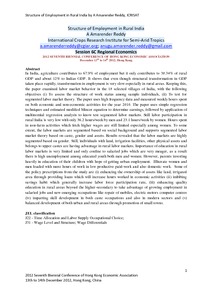Structure of Employment in Rural India
Abstract
In India, agriculture contributes to 67.9% of employment but it only contributes to 38.34% of rural GDP and about 12% to Indias GDP. It shows that even though structural transformation in GDP taken place rapidly, transformation in employment is very slow especially in rural areas. Keeping this, the paper examined labor market behavior in the 18 selected villages of India, with the following objectives (i) To assess the structure of work status among sample individuals, (ii) To test for segmented labor market theory. The paper uses high frequency data and measured weekly hours spent on both economic and non-economic activities for the year 2010. The paper uses simple regression techniques and estimated modified Mincer equation to determine earnings, followed by application of multinomial regression analysis to know test segmented labor markets. Still labor participation in rural India is very low with only 36.2 hours/week by men and 23.1 hours/week by women. Hours spent in non-farm activities which fetch higher wages are still limited especially among women. To some extent, the labor markets are segmented based on social background and supports segmented labor market theory based on caste, gender and assets. Results revealed that the labor markets are highly segmented based on gender. Still, individuals with land, irrigation facilities, other physical assets and belongs to upper castes are having advantage in rural labor markets. Importance of education in rural labor markets is very limited and only confine to salaried jobs which are very meager, as a result there is high unemployment among educated youth both men and women. However, parents investing heavily in education of their children with hope of getting urban employment. Illiterate women and men loaded with more hours of work in low productive paid-work and also domestic work. Some of the policy prescriptions from the study are (i) enhancing the ownership of assets like land, irrigated area through providing loans which will increase hours worked in economic activities (ii) imbibing savings habit which generally increase labor force participation rate, (iii) enhancing quality education in rural areas beyond the higher-secondary to take advantage of growing employment in salaried jobs and new emerging occupations like repair of mobiles, electric motors computer centres (iv) imparting skill development in both caste occupations and also in modern sectors and (v) balanced development of both urban and rural areas through promotion of small towns

